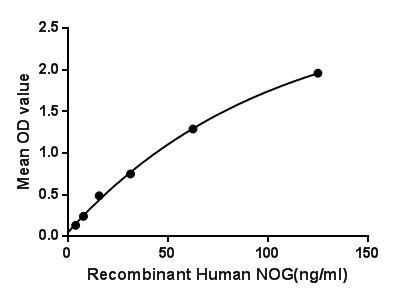Active Noggin (NOG)
SYM1; SYNS1; Synostoses(Multiple)Syndrome 1; Symphalangism 1(Proximal)
- Product No.APC130Hu01
- Organism SpeciesHomo sapiens (Human) Same name, Different species.
- Buffer Formulation20mM Tris, 150mM NaCl, pH8.0, containing 1mM EDTA, 1mM DTT, 0.01% SKL, 5% Trehalose and Proclin300.
- TraitsFreeze-dried powder
- Purity> 95%
- Isoelectric Point9.1
- ApplicationsCell culture; Activity Assays.
- Download Instruction Manual
- UOM 10µg50µg 200µg 1mg 5mg
-
FOB
US$ 222
For more details, please contact local distributors!US$ 554
For more details, please contact local distributors! US$ 1108
For more details, please contact local distributors! US$ 3324
For more details, please contact local distributors! US$ 8310
For more details, please contact local distributors!
ACTIVITY TEST of the Active Noggin (NOG)

Figure. The binding activity of NOG with CDF5.
Noggin, also known as NOG, is a protein that is involved in the development of many body tissues, including nerve tissue, muscles, and bones. Noggin is a signaling molecule that plays an important role in promoting somite patterning in the developing embryo. It is released from the notochord and regulates bone morphogenic protein (BMP4) during development. It also causes formation of the head and other dorsal structures. Besides, Growth Differentiation Factor 5 (GDF5) has been identified as an interactor of NOG, thus a binding ELISA assay was conducted to detect the interaction of recombinant human NOG and recombinant human CDF5. Briefly, NOG were diluted serially in PBS with 0.01% BSA (pH 7.4). Duplicate samples of 100uL were then transferred to CDF5-coated microtiter wells and incubated for 2h at 37℃. Wells were washed with PBST and incubated for 1h with anti-NOG pAb, then aspirated and washed 3 times. After incubation with HRP labelled secondary antibody, wells were aspirated and washed 3 times. With the addition of substrate solution, wells were incubated 15-25 minutes at 37℃. Finally, add 50µL stop solution to the wells and read at 450nm immediately. The binding activity of NOG and CDF5 was shown in Figure 1, and this effect was in a dose dependent manner.
USAGE of the Active Noggin (NOG)
Reconstitute in 20mM Tris, 150mM NaCl (PH8.0) to a concentration of 0.1-1.0 mg/mL. Do not vortex.
STORAGE of the Active Noggin (NOG)
Avoid repeated freeze/thaw cycles. Store at 2-8°C for one month. Aliquot and store at -80°C for 12 months.
STABILITY of the Active Noggin (NOG)
The thermal stability is described by the loss rate. The loss rate was determined by accelerated thermal degradation test, that is, incubate the protein at 37°C for 48h, and no obvious degradation and precipitation were observed. The loss rate is less than 5% within the expiration date under appropriate storage condition.
INCREMENT SERVICES
BCA Protein Quantification Kit
Molecular Mass Marker for Protein
Monoclonal Antibody Customized Service
Polyclonal Antibody Customized Service
Protein Activity Test Experiment Service
Electrophoretic Mobility Shift Assay (EMSA) Experiment Service
Buffer
Lentivirus Packaging Experiment Service
Adenovirus Packaging Experiment Service
Real Time PCR Experimental Service
Spike RBD Protein (S-RBD)
Protein G
Protein A
Related products
| Catalog No. | Organism species: Homo sapiens (Human) | Applications (RESEARCH USE ONLY!) |
| APC130Hu01 | Active Noggin (NOG) | Cell culture; Activity Assays. |
| RPC130Hu01 | Recombinant Noggin (NOG) | Positive Control; Immunogen; SDS-PAGE; WB. |
| RPC130Hu02 | Recombinant Noggin (NOG) | Positive Control; Immunogen; SDS-PAGE; WB. |
| EPC130Hu61 | Eukaryotic Noggin (NOG) | Positive Control; Immunogen; SDS-PAGE; WB. |
| PAC130Hu01 | Polyclonal Antibody to Noggin (NOG) | WB; IHC; ICC; IP. |
| PAC130Hu02 | Polyclonal Antibody to Noggin (NOG) | WB; IHC; ICC; IP. |
| LAC130Hu71 | Biotin-Linked Polyclonal Antibody to Noggin (NOG) | WB; IHC; ICC. |
| LAC130Hu81 | FITC-Linked Polyclonal Antibody to Noggin (NOG) | WB; IHC; ICC; IF. |
| MAC130Hu21 | Monoclonal Antibody to Noggin (NOG) | WB; IHC; ICC; IP. |
| MAC130Hu22 | Monoclonal Antibody to Noggin (NOG) | WB,IHC |
| MAC130Hu24 | Monoclonal Antibody to Noggin (NOG) | WB,IHC |
| MAC130Hu26 | Monoclonal Antibody to Noggin (NOG) | WB,IHC |
| LAC130Hu76 | Biotin-Linked Monoclonal Antibody to Noggin (NOG) | WB; IHC; ICC. |
| SEC130Hu | ELISA Kit for Noggin (NOG) | Enzyme-linked immunosorbent assay for Antigen Detection. |
| LMC130Hu | Multiplex Assay Kit for Noggin (NOG) ,etc. by FLIA (Flow Luminescence Immunoassay) | FLIA Kit for Antigen Detection. |
| PSC130Hu01 | Antibody Pair for Noggin (NOG) | ELISA; CLIA; ELISPOT; Luminex; Immunochromatography and other Immunoassays. |
| KSC130Hu01 | ELISA Kit DIY Materials for Noggin (NOG) | Main materials for "Do It (ELISA Kit) Yourself". |

